Fe(III)-Based Nanomicelles for Magnetic Resonance Imaging of Colorectal Cancer with Hepatic Metastasis
Abstract
1. Introduction
2. Materials and Methods
2.1. Materials
2.2. Characterization
2.3. Synthesis of N-Phenoxycarbonyl-sarcosine (Sar-NPC) and N-Phenoxycarbonyl-3,4-dihydroxy-L-phenylalanine (DOPA-NPC)
2.4. Diblock Copolymerization of DOPA-NPC with Sar-NPC
2.5. Preparation of Fe@POS Nanomicelles
2.6. Cell Culture and Animal Models
2.7. MRI Analysis
2.8. Biodistribution and Histological Analysis
3. Results and Discussion
3.1. Synthesis and Characterization of Fe@POS Nanomicelles
3.2. In Vitro and In Vivo T1-Weighted MRI in CRC and CRLM Models
3.3. Biosafety and Body Distribution of Fe@POS Nanomicelles
4. Conclusions
Supplementary Materials
Author Contributions
Funding
Institutional Review Board Statement
Informed Consent Statement
Data Availability Statement
Acknowledgments
Conflicts of Interest
Abbreviations
| CRC | Colorectal cancer |
| DCE-MRI | Dynamic contrast-enhanced magnetic resonance imaging |
| CRLM | Colorectal cancer liver metastasis |
| GBCA | Gadolinium-based contrast agent |
| NSF | Nephrogenic systemic fibrosis |
| EPR | Enhanced permeability and retention |
| PAA | Poly(α-amino acid) |
| SNR | Signal-to-noise ratio |
References
- Siegel, R.L.; Giaquinto, A.N.; Jemal, A. Cancer Statistics, 2024. CA Cancer J. Clin. 2024, 74, 12–49. [Google Scholar] [CrossRef]
- Sung, H.; Ferlay, J.; Siegel, R.L.; Laversanne, M.; Soerjomataram, I.; Jemal, A.; Bray, F. Global Cancer Statistics 2020: Globocan Estimates of Incidence and Mortality Worldwide for 36 Cancers in 185 Countries. CA Cancer J. Clin. 2021, 71, 209–249. [Google Scholar] [CrossRef]
- Cao, W.; Chen, H.D.; Yu, Y.W.; Li, N.; Chen, W.Q. Changing Profiles of Cancer Burden Worldwide and in China: A Secondary Analysis of the Global Cancer Statistics 2020. Chin. Med. J. 2021, 134, 783–791. [Google Scholar] [CrossRef]
- Siegel, R.L.; Wagle, N.S.; Cercek, A.; Smith, R.A.; Jemal, A. Colorectal Cancer Statistics, 2023. CA Cancer J. Clin. 2023, 73, 233–254. [Google Scholar] [CrossRef]
- Dekker, E.; Tanis, P.J.; Vleugels, J.L.A.; Kasi, P.M.; Wallace, M.B. Colorectal Cancer. Lancet 2019, 394, 1467–1480. [Google Scholar] [CrossRef]
- Zampino, M.G.; Magni, E.; Ravenda, P.S.; Cella, C.A.; Bonomo, G.; Della Vigna, P.; Galdy, S.; Spada, F.; Varano, G.M.; Mauri, G.; et al. Treatments for Colorectal Liver Metastases: A New Focus on a Familiar Concept. Crit. Rev. Oncol. Hematol. 2016, 108, 154–163. [Google Scholar] [CrossRef]
- Zhou, Z.; Lu, Z.R. Gadolinium-Based Contrast Agents for Magnetic Resonance Cancer Imaging. Wiley Interdiscip Rev Nanomed Nanobiotechnol 2013, 5, 1–18. [Google Scholar] [CrossRef]
- Kircher, M.F.; Willmann, J.K. Molecular Body Imaging: MR imaging, CT, and US. Part I. Principles. Radiology 2012, 263, 633–643. [Google Scholar] [CrossRef]
- Lin, Y.H.; Hwang, R.M.; Chen, B.B.; Hsu, C.Y.; Yu, C.W.; Kao, J.H.; Lee, H.S.; Liang, P.C.; Wei, S.Y.; Shih, T.T. Vascular and Hepatic Enhancements at MR Imaging: Comparison of Gd-EOB-DTPA and Gd-DTPA in the Same Subjects. Clin. Imaging 2014, 38, 287–291. [Google Scholar] [CrossRef]
- Bhave, G.; Lewis, J.B.; Chang, S.S. Association of Gadolinium Based Magnetic Resonance Imaging Contrast Agents and Nephrogenic Systemic Fibrosis. J. Urol. 2008, 180, 830–835. [Google Scholar] [CrossRef]
- Todd, D.J.; Kay, J. Gadolinium-Induced Fibrosis. Annu. Rev. Med. 2016, 67, 273–291. [Google Scholar] [CrossRef]
- Penfield, J.G.; Reilly, R.F., Jr. What Nephrologists Need to Know About Gadolinium. Nat. Clin. Pract. Nephrol. 2007, 3, 654–668. [Google Scholar] [CrossRef]
- Kras, E.A.; Snyder, E.M.; Sokolow, G.E.; Morrow, J.R. Distinct Coordination Chemistry of Fe(III)-Based MRI Probes. Acc. Chem. Res. 2022, 55, 1435–1444. [Google Scholar] [CrossRef]
- Palagi, L.; Di Gregorio, E.; Costanzo, D.; Stefania, R.; Cavallotti, C.; Capozza, M.; Aime, S.; Gianolio, E. Fe(Deferasirox)(2): An Iron(III)-Based Magnetic Resonance Imaging T(1) Contrast Agent Endowed with Remarkable Molecular and Functional Characteristics. J. Am. Chem. Soc. 2021, 143, 14178–14188. [Google Scholar] [CrossRef]
- Wahsner, J.; Gale, E.M.; Rodriguez-Rodriguez, A.; Caravan, P. Chemistry of MRI Contrast Agents: Current Challenges and New Frontiers. Chem. Rev. 2019, 119, 957–1057. [Google Scholar] [CrossRef]
- Suva, M.A.; Tirgar, P.R. Comparative Evaluation of Different Oral Iron Salts in the Management of Iron Deficiency Anemia. Daru 2024, 32, 485–494. [Google Scholar] [CrossRef]
- Kassianides, X.; Bodington, R.; Bhandari, S. An Evaluation of Ferric Derisomaltose as a Treatment for Anemia. Expert. Rev. Hematol. 2021, 14, 7–29. [Google Scholar] [CrossRef]
- Scott, L.J. Ferric Carboxymaltose: A Review in Iron Deficiency. Drugs 2018, 78, 479–493. [Google Scholar] [CrossRef]
- Yilmaz, A.; Rosch, S.; Yildiz, H.; Klumpp, S.; Sechtem, U. First Multiparametric Cardiovascular Magnetic Resonance Study Using Ultrasmall Superparamagnetic Iron Oxide Nanoparticles in a Patient with Acute Myocardial Infarction: New Vistas for the Clinical Application of Ultrasmall Superparamagnetic Iron Oxide. Circulation 2012, 126, 1932–1934. [Google Scholar] [CrossRef]
- Zhang, P.; Hou, Y.; Zeng, J.; Li, Y.; Wang, Z.; Zhu, R.; Ma, T.; Gao, M. Coordinatively Unsaturated Fe(3+) Based Activatable Probes for Enhanced MRI and Therapy of Tumors. Angew. Chem. Int. Ed. Engl. 2019, 58, 11088–11096. [Google Scholar] [CrossRef]
- Wan, Y.; An, L.; Zhu, Z.; Tian, Q.; Lin, J.; Yang, S. Iron–Polyphenol Dendritic Complexes for Regulating Amplification of Phenolic Hydroxyl Groups to Improve Magnetic Resonance Imaging. Chem. Eng. J. 2023, 458, 141322. [Google Scholar] [CrossRef]
- Zhang, C.; Li, J.; Yang, C.; Gong, S.; Jiang, H.; Sun, M.; Qian, C. A pH-Sensitive Coordination Polymer Network-Based Nanoplatform for Magnetic Resonance Imaging-Guided Cancer Chemo-Photothermal Synergistic Therapy. Nanomedicine 2020, 23, 102071. [Google Scholar] [CrossRef] [PubMed]
- Anselmo, A.C.; Kumar, S.; Gupta, V.; Pearce, A.M.; Ragusa, A.; Muzykantov, V.; Mitragotri, S. Exploiting Shape, Cellular-Hitchhiking and Antibodies to Target Nanoparticles to Lung Endothelium: Synergy Between Physical, Chemical And Biological Approaches. Biomaterials 2015, 68, 1–8. [Google Scholar] [CrossRef]
- Ishihara, A.; Yamauchi, M.; Tsuchiya, T.; Mimura, Y.; Tomoda, Y.; Katagiri, A.; Kamiya, M.; Nemoto, H.; Suzawa, T.; Yamasaki, M. A Novel Liposome Surface Modification Agent that Prolongs Blood Circulation and Retains Surface Ligand Reactivity. J. Biomater. Sci. Polym. Ed. 2012, 23, 2055–2068. [Google Scholar] [CrossRef]
- Huang, H.; Yue, T.; Xu, Y.; Xu, K.; Xu, H.; Liu, S.; Yu, J.; Huang, J. PEGylation of MnO Nanoparticles via Catechol–Mn Chelation to Improving T1-Weighted Magnetic Resonance Imaging Application. J. Appl. Polym. Sci. 2015, 132, 148–154. [Google Scholar] [CrossRef]
- Cepero, A.; Luque, C.; Cabeza, L.; Perazzoli, G.; Quinonero, F.; Mesas, C.; Melguizo, C.; Prados, J. Antibody-Functionalized Nanoformulations for Targeted Therapy of Colorectal Cancer: A Systematic Review. Int. J. Nanomed. 2022, 17, 5065–5080. [Google Scholar] [CrossRef]
- Sun, R.; Xiang, J.; Zhou, Q.; Piao, Y.; Tang, J.; Shao, S.; Zhou, Z.; Bae, Y.H.; Shen, Y. The Tumor EPR Effect for Cancer Drug Delivery: Current Status, Limitations, and Alternatives. Adv. Drug Deliv. Rev. 2022, 191, 114614. [Google Scholar] [CrossRef]
- Daruwalla, J.; Greish, K.; Nikfarjam, M.; Millar, I.; Malcontenti-Wilson, C.; Iyer, A.K.; Christophi, C. Evaluation of the Effect of SMA-Pirarubicin Micelles on Colorectal Cancer Liver Metastases and of Hyperbaric Oxygen in CBA Mice. J. Drug Target. 2007, 15, 487–495. [Google Scholar] [CrossRef]
- Zavradashvili, N.; Puiggali, J.; Katsarava, R. Artificial Polymers Made of Alpha-Amino Acids-Poly(Amino Acid)s, Pseudo-Poly(Amino Acid)s, Poly(Depsipeptide)s, and Pseudo-Proteins. Curr. Pharm. Des. 2020, 26, 566–593. [Google Scholar] [CrossRef]
- Peng, G.; Li, G.; Zhou, F.; Shen, T.; Lyu, J.; Liu, Z.; Ling, J.; Sun, J. Bismuth-Loaded Poly(Alpha-Amino Acid) Nanoparticles for CT and Fluorescence Bimodal Imaging. Biomacromolecules 2025, 26, 1873–1881. [Google Scholar] [CrossRef] [PubMed]
- Sun, W.; Xu, S.; Shen, T.; Li, G.; Zhang, J.; Pan, C.; Lu, W.; Liu, X.; Zheng, J.; Ling, J.; et al. Fe(3+)@PDOPA-b-PSar Nanoparticles for Magnetic Resonance Imaging and Cancer Chemotherapy. Int. J. Nanomed. 2023, 18, 2197–2208. [Google Scholar] [CrossRef]
- Demirci, G.; Guven, M.N.; Altuncu, S.; Konca, Y.U.; Avci, D.; Yagci Acar, H. (Bis)Phosphonic Acid-Functionalized Poly(Ethyleneimine)–Poly(Amido Amine)s for Selective In Vitro Transfection of Osteosarcoma Cells. ACS Appl. Polym. Mater. 2021, 3, 3776–3787. [Google Scholar] [CrossRef]
- Sun, J.; Huang, X.; Shi, R.; Ji, T.; Ding, J.; Chen, X. Enzyme-Triggered Orthotopic Network Formation from Poly(Amino Acid) Nanoparticle to Suppress Tumor Growth and Metastases. Nano Today 2024, 56, 102222. [Google Scholar] [CrossRef]
- Wang, T.; Qi, Y.; Miyako, E.; Bianco, A.; Menard-Moyon, C. Photocrosslinked Co-Assembled Amino Acid Nanoparticles for Controlled Chemo/Photothermal Combined Anticancer Therapy. Small 2024, 20, e2307337. [Google Scholar] [CrossRef]
- Sasidharan, S.; Bahadur, D.; Srivastava, R. Protein-Poly(Amino Acid) Nanocore-Shell Mediated Synthesis of Branched Gold Nanostructures for Computed Tomographic Imaging and Photothermal Therapy of Cancer. ACS Appl. Mater. Interfaces 2016, 8, 15889–15903. [Google Scholar] [CrossRef]
- Zhou, Z.; Yang, L.; Gao, J.; Chen, X. Structure–Relaxivity Relationships of Magnetic Nanoparticles for Magnetic Resonance Imaging. Adv Mater 2019, 31, e1804567. [Google Scholar] [CrossRef]
- Oh, J.; Kang, D.; Hong, S.; Kim, S.H.; Choi, J.-H.; Seo, J. Formation of a Tris(Catecholato) Iron(Iii) Complex with a Na-ture-Inspired Cyclic Peptoid Ligand. Dalton Trans. 2021, 50, 3459–3463. [Google Scholar] [CrossRef]
- Sever, M.J.; Wilker, J.J. Visible Absorption Spectra of Metal–Catecholate and Metal–Tironate Complexes. Dalton Trans. 2004, 1061–1072. [Google Scholar] [CrossRef]
- Maheshwaran, D.; Nagendraraj, T.; Sekar Balaji, T.; Kumaresan, G.; Senthil Kumaran, S.; Mayilmurugan, R. Smart Dual T1 Mri-Optical Imaging Agent Based on a Rhodamine Appended Fe(Iii)-Catecholate Complex. Dalton Trans. 2020, 49, 14680–14689. [Google Scholar] [CrossRef]
- Chen, J.W.; Belford, R.L.; Clarkson, R.B. Second-Sphere and Outer-Sphere Proton Relaxation of Paramagnetic Complexes: From Epr to Nmrd. J. Phys. Chem. A 1998, 102, 2117–2130. [Google Scholar] [CrossRef]
- Tong, X.; Wang, Z.; Sun, X.; Song, J.; Jacobson, O.; Niu, G.; Kiesewetter, D.O.; Chen, X. Size Dependent Kinetics of Gold Nanorods in EPR Mediated Tumor Delivery. Theranostics 2016, 6, 2039–2051. [Google Scholar] [CrossRef] [PubMed]
- Sharifi, M.; Cho, W.C.; Ansariesfahani, A.; Tarharoudi, R.; Malekisarvar, H.; Sari, S.; Bloukh, S.H.; Edis, Z.; Amin, M.; Gleghorn, J.P.; et al. An Updated Review on EPR-Based Solid Tumor Targeting Nanocarriers for Cancer Treatment. Cancers 2022, 14, 2868. [Google Scholar] [CrossRef] [PubMed]
- De Angelis, M.L.; Francescangeli, F.; Nicolazzo, C.; Xhelili, E.; La Torre, F.; Colace, L.; Bruselles, A.; Macchia, D.; Vitale, S.; Gazzaniga, P.; et al. An Orthotopic Patient-Derived Xenograft (PDX) Model Allows the Analysis of Metastasis-Associated Features in Colorectal Cancer. Front. Oncol. 2022, 12, 869485. [Google Scholar] [CrossRef] [PubMed]
- Sorski, L.; Levi, B.; Shaashua, L.; Neeman, E.; Benish, M.; Matzner, P.; Hoffman, A.; Ben-Eliyahu, S. The Impact of Surgical Extent and Sex on the Hepatic Metastasis of Colon Cancer. Surg. Today 2013, 44, 1925–1934. [Google Scholar] [CrossRef]
- Samuelsson, E.; Shen, H.; Blanco, E.; Ferrari, M.; Wolfram, J. Contribution of Kupffer Cells to Liposome Accumulation in the Liver. Colloids Surf. B Biointerfaces 2017, 158, 356–362. [Google Scholar] [CrossRef]
- Ouyang, B.; Poon, W.; Zhang, Y.-N.; Lin, Z.P.; Kingston, B.R.; Tavares, A.J.; Zhang, Y.; Chen, J.; Valic, M.S.; Syed, A.M.; et al. The Dose Threshold for Nanoparticle Tumour Delivery. Nat. Mater. 2020, 19, 1362–1371. [Google Scholar] [CrossRef]
- Poon, W.; Zhang, Y.-N.; Ouyang, B.; Kingston, B.R.; Wu, J.L.Y.; Wilhelm, S.; Chan, W.C.W. Elimination Pathways of Nanoparticles. ACS Nano 2019, 13, 5785–5798. [Google Scholar] [CrossRef]
- Kan, Z.; Ivancev, K.; Lunderquist, A.; Mccuskey, P.A.; Mccuskey, R.S.; Wallace, S. In Vivomicroscopy of Hepatic Metastases: Dynamic Observation of Tumor Cell Invasion and Interaction with Kupffer Cells. Hepatology 1995, 21, 487–494. [Google Scholar] [CrossRef]
- Zhang, H.; Guo, Y.; Jiao, J.; Qiu, Y.; Miao, Y.; He, Y.; Li, Z.; Xia, C.; Li, L.; Cai, J.; et al. A Hepatocyte-Targeting Nanoparticle for Enhanced Hepatobiliary Magnetic Res-onance Imaging. Nat. Biomed. Eng. 2022, 7, 221–235. [Google Scholar] [CrossRef]
- Kim, S.M.; Im, G.H.; Lee, D.-G.; Lee, J.H.; Lee, W.J.; Lee, I.S. Mn2+-Doped Silica Nanoparticles for Hepatocyte-Targeted Detection of Liver Cancer in T1-Weighted Mri. Biomaterials 2013, 34, 8941–8948. [Google Scholar] [CrossRef]
- Fritz, T.; Unger, E.; Wilson-Sanders, S.; Ahkong, Q.F.; Tilcock, C. Detailed Toxicity Studies of Liposomal Gadolinium-DTPA. Investig. Radiol. 1991, 26, 960–968. [Google Scholar] [CrossRef] [PubMed]
- Lu, W.; Wang, X.; Cheng, R.; Deng, C.; Meng, F.; Zhong, Z. Biocompatible and Bioreducible Micelles Fabricated from Novel α-Amino Acid-Based Poly(Disulfide Urethane)s: Design, Synthesis and Triggered Doxorubicin Release. Polym. Chem. 2015, 6, 6001–6010. [Google Scholar] [CrossRef]
- Díaz, A.; Katsarava, R.; Puiggalí, J. Synthesis, Properties and Applications of Biodegradable Polymers Derived from Diols and Dicarboxylic Acids: From Polyesters to Poly(Ester Amide)s. Int. J. Mol. Sci. 2014, 15, 7064–7123. [Google Scholar] [CrossRef] [PubMed]
- ISO 10993-11:2017; Biological Evaluation of Medical Devices Part 11: Tests for Systemic Toxicity. ISO: Geneva, Switzerland, 2017.
- Pham, T.T.; Liney, G.P.; Wong, K.; Barton, M.B. Functional MRI for Quantitative Treatment Response Prediction in Locally Advanced Rectal Cancer. Br. J. Radiol. 2017, 90, 20151078. [Google Scholar] [CrossRef]
- Van Cutsem, E.; Verheul, H.; Flamen, P.; Rougier, P.; Beets-Tan, R.; Glynne-Jones, R.; Seufferlein, T. Imaging in Colorectal Cancer: Progress and Challenges for the Clinicians. Cancers 2016, 8, 81. [Google Scholar] [CrossRef]

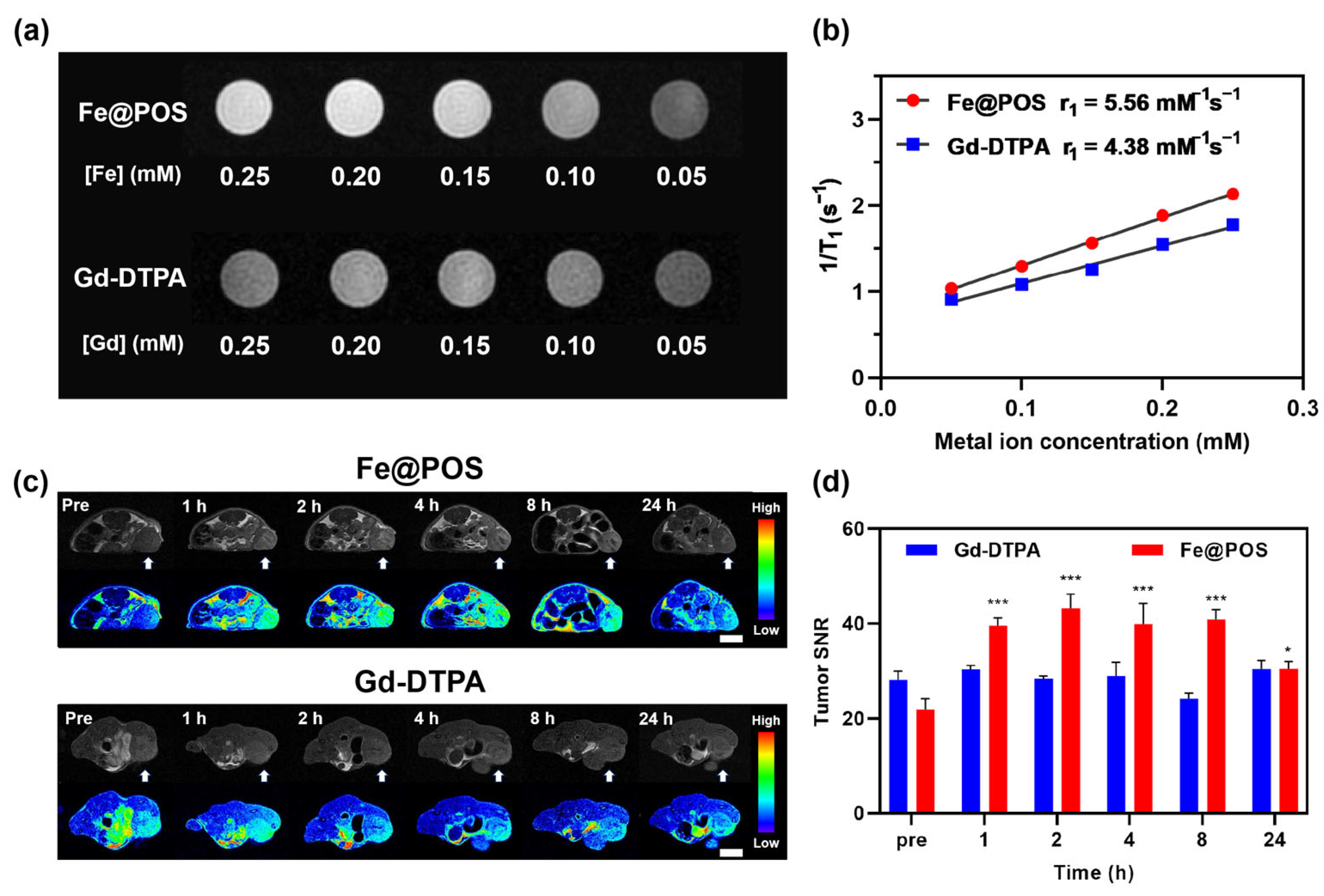
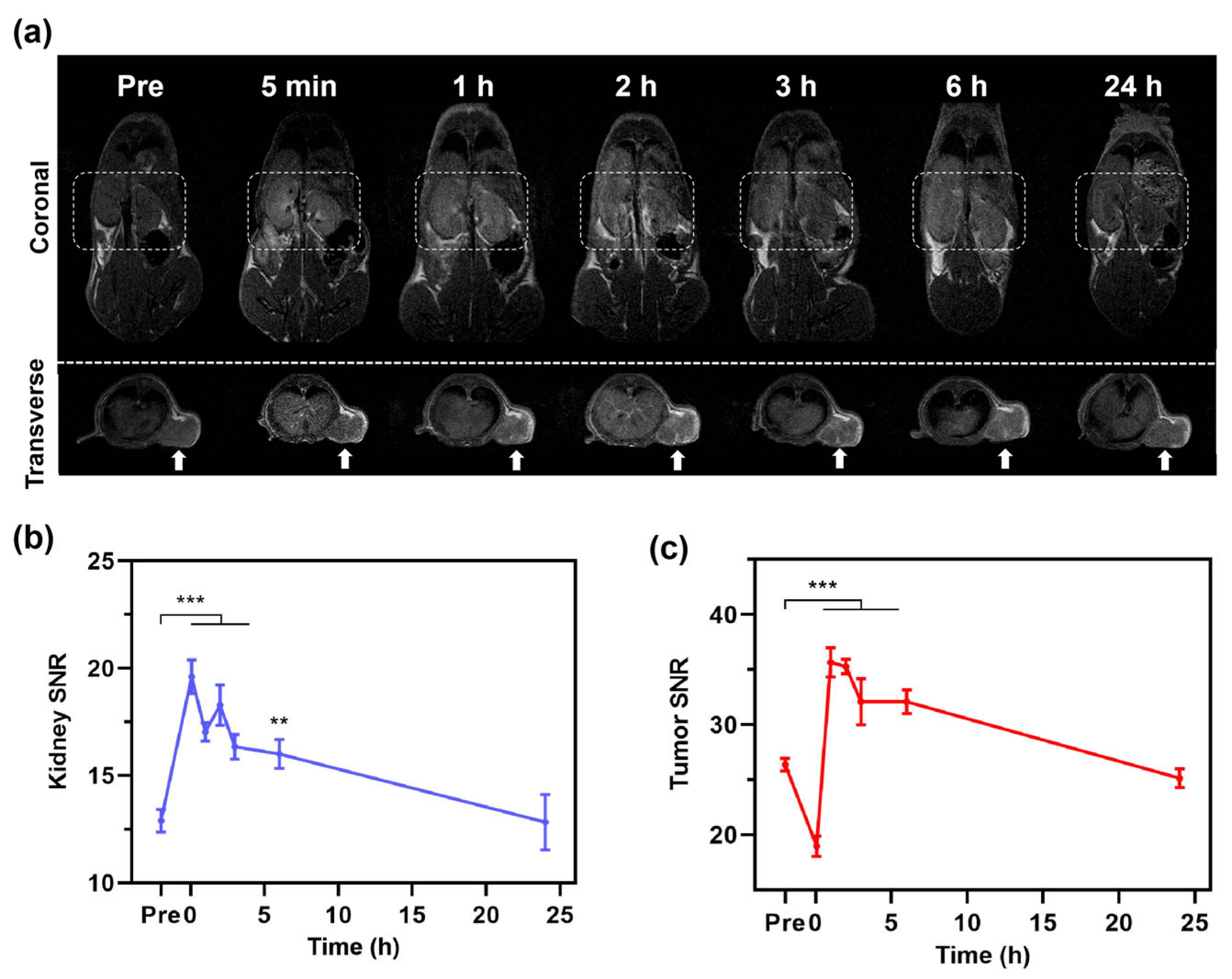
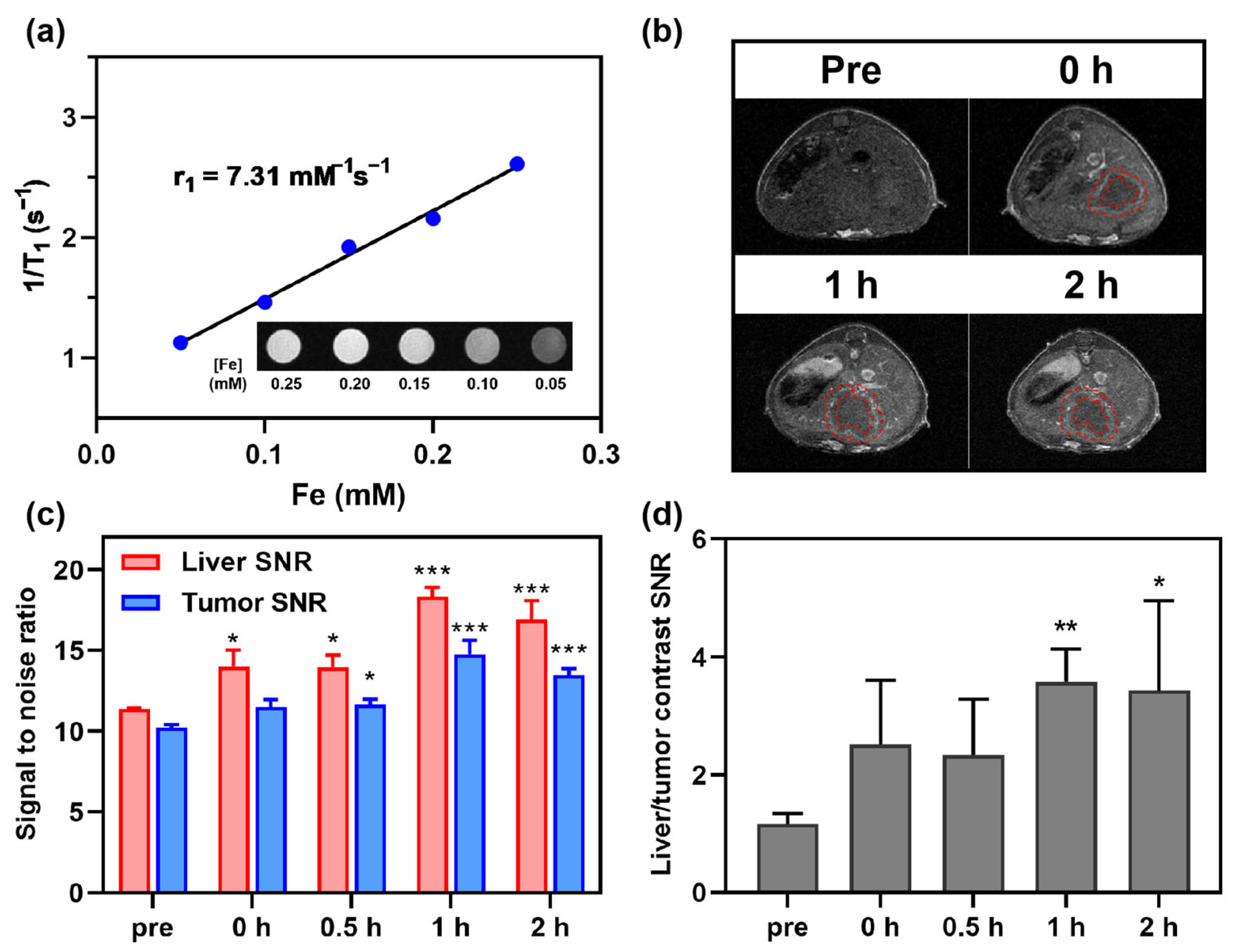
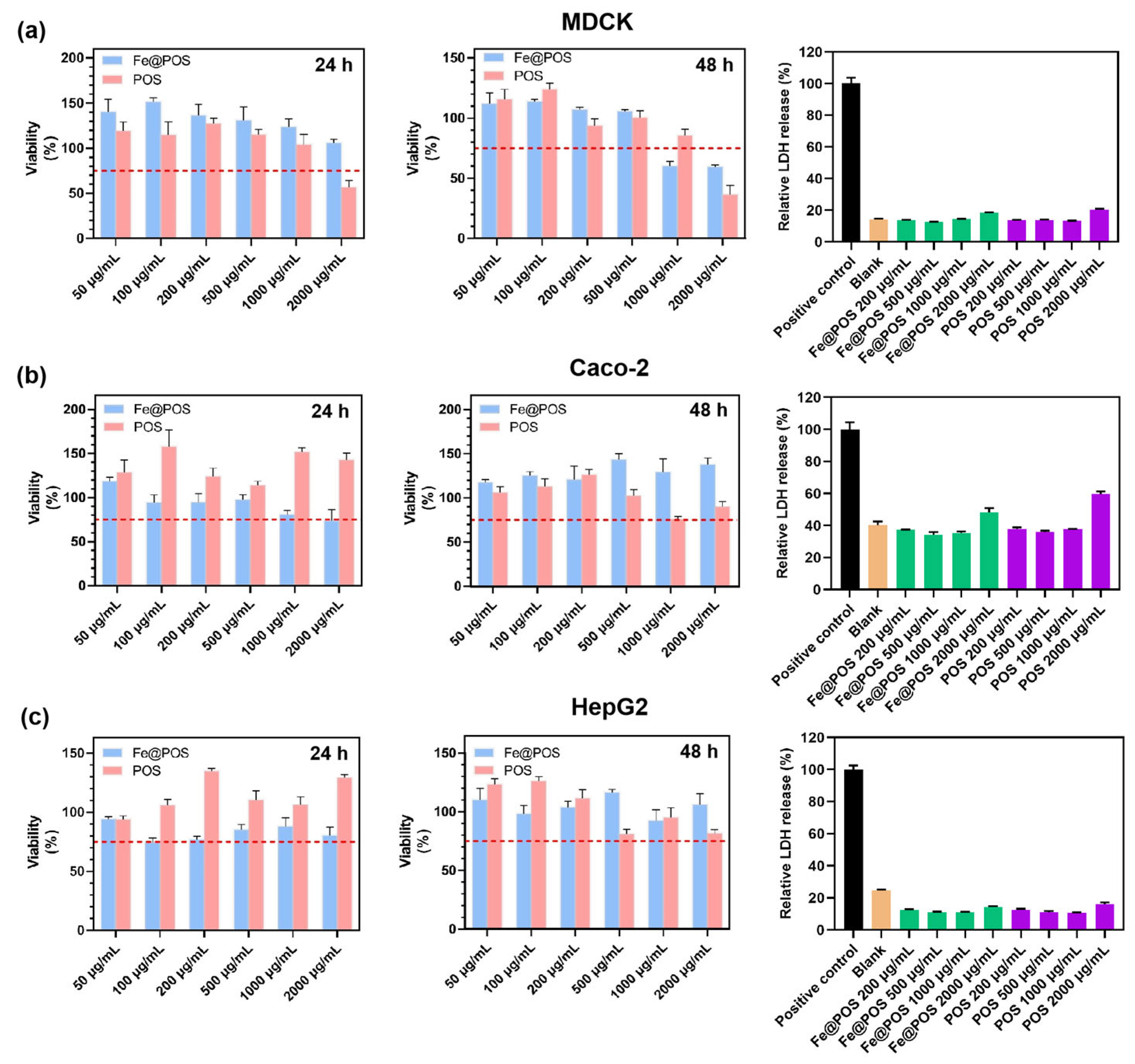
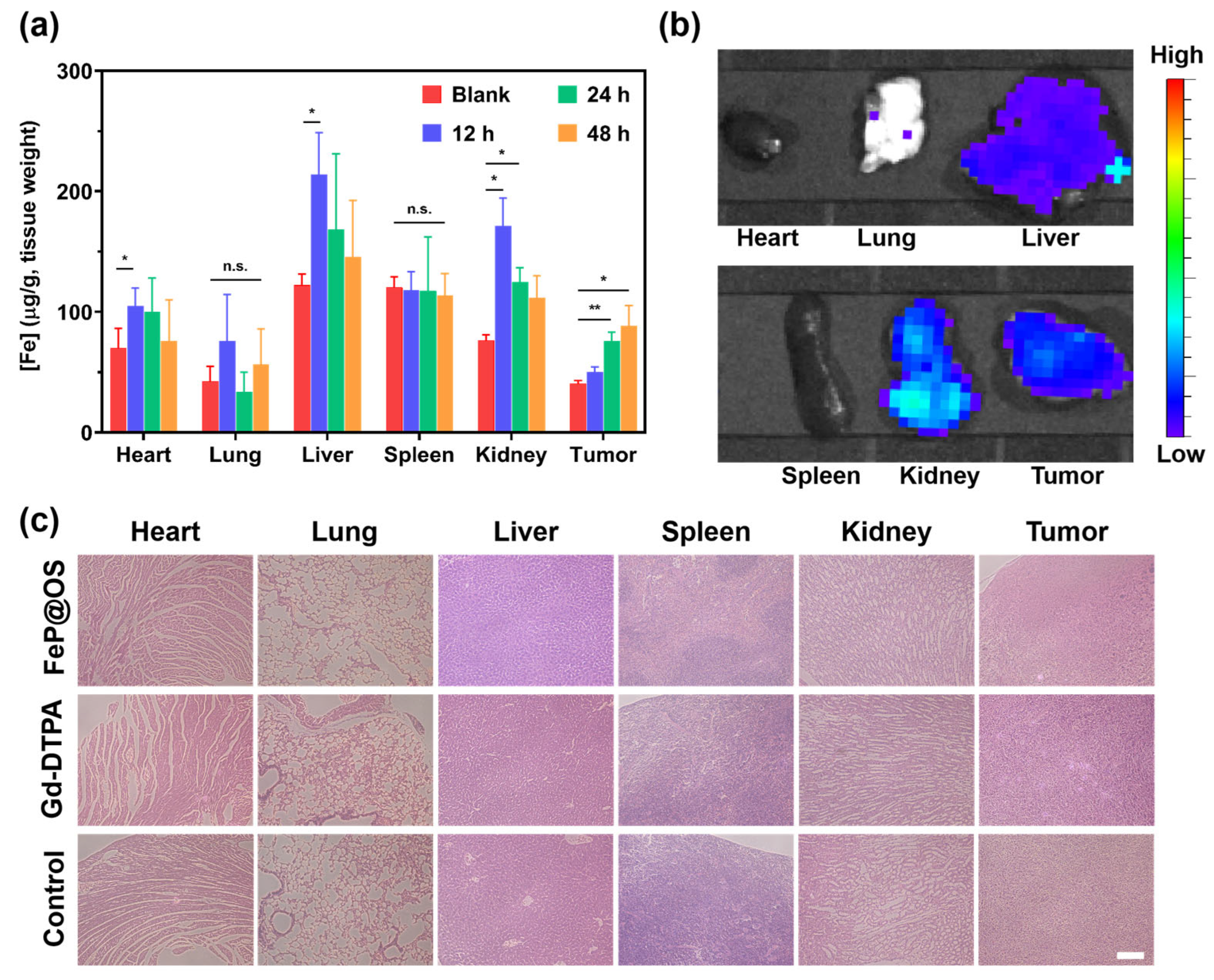
Disclaimer/Publisher’s Note: The statements, opinions and data contained in all publications are solely those of the individual author(s) and contributor(s) and not of MDPI and/or the editor(s). MDPI and/or the editor(s) disclaim responsibility for any injury to people or property resulting from any ideas, methods, instructions or products referred to in the content. |
© 2025 by the authors. Licensee MDPI, Basel, Switzerland. This article is an open access article distributed under the terms and conditions of the Creative Commons Attribution (CC BY) license (https://creativecommons.org/licenses/by/4.0/).
Share and Cite
Shen, T.; Lv, K.; Chen, Z.; Xu, S.; Li, G.; Han, G.; Wáng, Y.X.J.; Ling, J.; Sun, J. Fe(III)-Based Nanomicelles for Magnetic Resonance Imaging of Colorectal Cancer with Hepatic Metastasis. J. Funct. Biomater. 2025, 16, 229. https://doi.org/10.3390/jfb16070229
Shen T, Lv K, Chen Z, Xu S, Li G, Han G, Wáng YXJ, Ling J, Sun J. Fe(III)-Based Nanomicelles for Magnetic Resonance Imaging of Colorectal Cancer with Hepatic Metastasis. Journal of Functional Biomaterials. 2025; 16(7):229. https://doi.org/10.3390/jfb16070229
Chicago/Turabian StyleShen, Tianlun, Kaiwei Lv, Zhenyan Chen, Songyi Xu, Guangyao Li, Guocan Han, Yì Xiáng J. Wáng, Jun Ling, and Jihong Sun. 2025. "Fe(III)-Based Nanomicelles for Magnetic Resonance Imaging of Colorectal Cancer with Hepatic Metastasis" Journal of Functional Biomaterials 16, no. 7: 229. https://doi.org/10.3390/jfb16070229
APA StyleShen, T., Lv, K., Chen, Z., Xu, S., Li, G., Han, G., Wáng, Y. X. J., Ling, J., & Sun, J. (2025). Fe(III)-Based Nanomicelles for Magnetic Resonance Imaging of Colorectal Cancer with Hepatic Metastasis. Journal of Functional Biomaterials, 16(7), 229. https://doi.org/10.3390/jfb16070229









